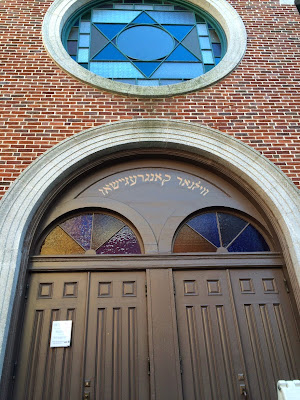One day in winter, I went into Boston and went to the Vilna Shul, the last intact immigrant-era synagogue in Boston.
To get there I walked by the Mass. State House and a few blocks up to get to the shul. It was between snow storms, I believe, and you can see the snow (over 4' deep) around.
 |
| Capitol in Snow |
 |
| Icicles hanging from condo building |
 |
| Removing snow along walk to shul |
 |
| Entry to Shul: In Yiddish: Vilnar Congregation |
 |
| Sing outside door of synagogue |
In 1919, first and second generation Jewish immigrants, mostly from Vilna, Lithuania built a synagogue in their new home, the Boston West End. The members helped to build the synagogue and painted murals on the inside as was their custom in Europe. The shul became the center for prayer, community and learning for more than 60 years. Most of these people were poorer than other Jews in Boston. The synagogue used to be filled for the High Holidays and Yiddish was spoken among the people. At one point there were 53 small synagogues Boston, most in this area for people from different areas of Europe. Many of these central ones closed as Jews moved from the tenements of the North and Wext ends to other Boston areas including Roxbury and also to the suburbs.
This synagogue has not been used for prayer since the mid 1980s when the last member was attacked while closing after sunset in 1985. He had been getting local students to come in for a minyan for prayers for years, but after the attack, he stopped as it had become too dangerous for him. The building was closed for about ten years. Birds got in and the inside was a mess. The last member tried to sell the synagogue but since there were no other board members (he needed a total of 3), he could not. The State then put it up for sale to similar organizations. One synagogue wanted to get it to tear down for parking as a sign of the times. The Boston Center for Jewish Heritage was created in the mid-1990s and in 1995, the shul was bought by the group for a nominal amount. It has been restored (work continues) as a historical museum, with offices at the entry. The sanctuary is open to the public and a history of the Jews in Boston is in the basement. The organization has had reunions of past members and their descendants which have grown in popularity.
The current building is the final one of 3 used by the group and the first one that was built /remodeled for them and the cornerstone laid in late 1919. When the group moved from the Baptist church, they took the pews with them. The sides of the pews were "altered" to remove the horizontal cross.
The ark was also brought from the Baptist church.
The synagogue is open Wednesdays--Fridays from 11 to 5 with guided tours at 1 and 3, and possibly Sundays from 1 to 5. I was there a bit before 3 so got a private tour then, and it was wonderful!
First she began with a history of the West and North ends. The whole area was marshy. A prison and hospital had been built in the West End as no one else wanted to live there and it was best for "undesirables" including the sick. The area was cheap and African Americans lived there mostly until the 1870s and prostitutes also inhabited the area. It was one of the first areas in the US where Jews followed African Americans.
In 1798, the State House was moved to its current location and Beacon Hill became a white protestant neighborhood. Back Bay was then planned in the mid-1800s and a filling in of the swampy area began. More minorities moved into those areas. The following map at the shul showed the expansion. The area inside the black was the original land area. The area outside of the black is what had been marshy swamp and was filled in. Poorer people were pushed back into those areas to live.
This is what the sanctuary looks like now:
 |
| the original men's section--women's is off to the right |
 |
| The Bimah (pulpit and ark) |
 |
| Bimah close up |
 |
| Torah Holder |
 |
| The Women's section |
 |
| Close up of mural of Rachel's Tomb in women's section; notice the women members listed to the left |
 |
| Newest example of murals |
 |
| A partial list of men members, located near back of sanctuary |
 |
| Close up of part of women members |
Downstairs there were many boards with pictures of synagogues and areas where Jews lived as well as charts of the numbers in certain areas as certain times.
 |
| Example of poster and picture of Jews from the past in the Boston area |
For more information on the Jewish culture center and the shul, please go to
http://www.vilnashul.org/about/our_history
An article of the descendants visiting the shul can be found at:
http://www.bostonglobe.com/metro/2013/12/01/vilna-shul-beacon-hill-home-for-jewish-emigres-decades-past-gathers-descendants/nJyZEizMQpo9BYD6WoBXJK/story.html







No comments:
Post a Comment